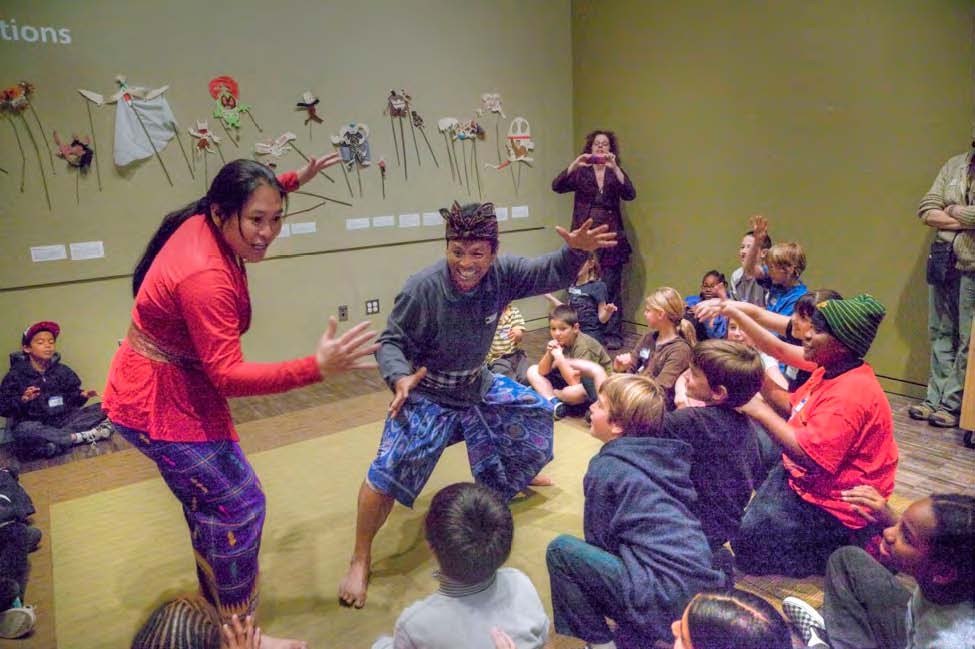Activity
Creating Story with Music
Objective: Students express the Balinese concept of working together to create a community by applying the kecak musical pattern of interlocking parts to "Mary Had a Little Lamb," and design their own chant using words or sounds to represent their characters.

Students from Chabot Elementary School, Oakland Unified School District, participate in the Balinese Monkey chant (kecak)
Comment Core Standards
SL 3.2.: Determine the main ideas and supporting details of a text read aloud or information presented in diverse media and formats, including visually, quantitatively, and orally.
Content Standards (California)
VPA/M 3.3.1: Identify the uses of music in various cultures and time periods.
VPA/M 3.3.2: 3.2 Sing memorized songs from diverse cultures.
Author
Sarah Willner, Music Integration Specialist.
Materials
Worksheets (see “Downloads” above): Creating Kecak Rhytmes; Story Summary of the Ramayana; Read Aloud Version of the Ramayana
Overview
Opposites can work together to make something greater than the individual parts. Bali is a small island, but it is home to many people. They have learned to work closely and cooperatively together, as in other island cultures. An important term in Bali is gotong royong, “working together.” The high value placed on team effort is manifested in the music, which is constructed so that the players are synchronized in complementary pairs. Two parts fit together to make a fast and complex composite pattern—one that neither player could accomplish alone. They are not only cooperating, but interdependent.
Kecak (pronounced “keh-CHAK”) is performed by a large group of performers—sometimes up to one hundred—sitting in concentric circles and chanting interlocking rhythms, singing, and enacting a highly synchronized choreography of arm movements, swaying, and leaning. Usually kecak accompanies a story, sung by a narrator. Dancers perform in the center of the circle; the kecak chorus might then become human props for the play, swaying like the trees or rolling like ocean waves.
Kecak originated as part of a healing or exorcistic ritual called Sang Hyang. In the 1930s it was adapted as a dramatic form, as performers in south-central Bali began to use this “mouth music” and its evocative movement vocabulary to accompany the Story of Rama play. This modern form of kecak has remained a popular presentation for international visitors and a fertile ground for contemporary new pieces.
Procedure
- Divide students up into two groups.
- Introduce the idea of interlocking by using familiar chants, such as “Mary Had a Little Lamb.”
- Start by having the whole group say the poem, “Mary Had a Little Lamb” together.
- Assign Group 1 the first word and Group 2 the second word and have them speak “Mary Had a Little Lamb” in alternation.
- Sing the song as a whole group first. Then, alternate the chant.
- Next, replace the words with a percussive sound: Group 1 can say ‘chak’ and Group 2 says ‘chook,’ while retaining the word rhythm of “Mary Had a Little Lamb.” So, words with one syllable have just one “chak” or “chook,” while words of two syllables have “chak-chak” or ”chook-chook.” Ask students to describe how the chant makes them feel, and what ideas and sensations emerge through this musical experience.
- Have both groups chant the same sound, again keeping to their “Mary” rhythms, for example both groups using ”chak.” This will make it sound like one big beehive of sound.
Interlocking with rhythm of the chant’s words
- Try a simple form of interlocking rhythms as done in Bali. The difference between the kecak rhythms and the previous exercise is that kecak patterns sometimes overlap, as can be seen in the table below. To help stay together, one or more chanters can “speak” the beat, using the sound ”poong,” which imitates the beat-keeping instrument in the gamelan orchestra.
- After trying it a few times to make it fluid—as if one person were speaking it—it is fun to let one group drop out, leaving blank spaces between the other group’s words. This is an easy way to convey the concept of audiation, the mental hearing of sound. Continue the underlying steady beat.
- Using Worksheet: Creating Kecak Rhymes, have students make up a chant inspired by their shadow puppet characters. Make up the rhythms, either by ear or with a blank template. Ask: What sense of character or story were you trying to convey with this chant? What did you have to do to stay together?
Freeze Dance
- Students cultivate, explore, and express empathy and understanding for the characters of the Ramayana. Read the Story Summary of the Ramayana or the Read Aloud Version of the Ramayana or watch the video The Abduction of Sita with your students and have the students embody the characters in different places in the Story of Rama. If your students are able, have them move around the room, rather than stay in place. Establish that Freeze Dance is a totally silent activity. Show us with your body, rather than with your mouth. Establish that there should be no touching each other.
- As students become used to the freezing routine, suggest that they freeze in a certain pose. For example, if they are being Hanuman, when the music stops ask them to freeze in a way that suggests they are a monkey on a tree limb. If they are sad King Dasharatha, have them move, then show their sadness when they freeze in a way that uses their facial expression. Or, prompt students to interact as different characters. For example, half the class might be the Golden Deer leaping about to entrance Sita, while the other half is Sita fascinated by the Golden Deer. This is a great way to develop a scene if you are performing the story.






